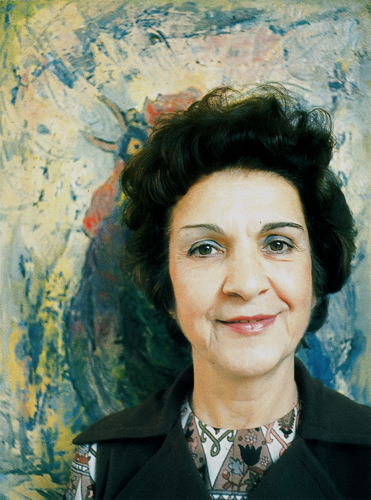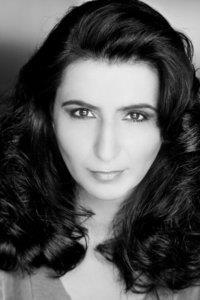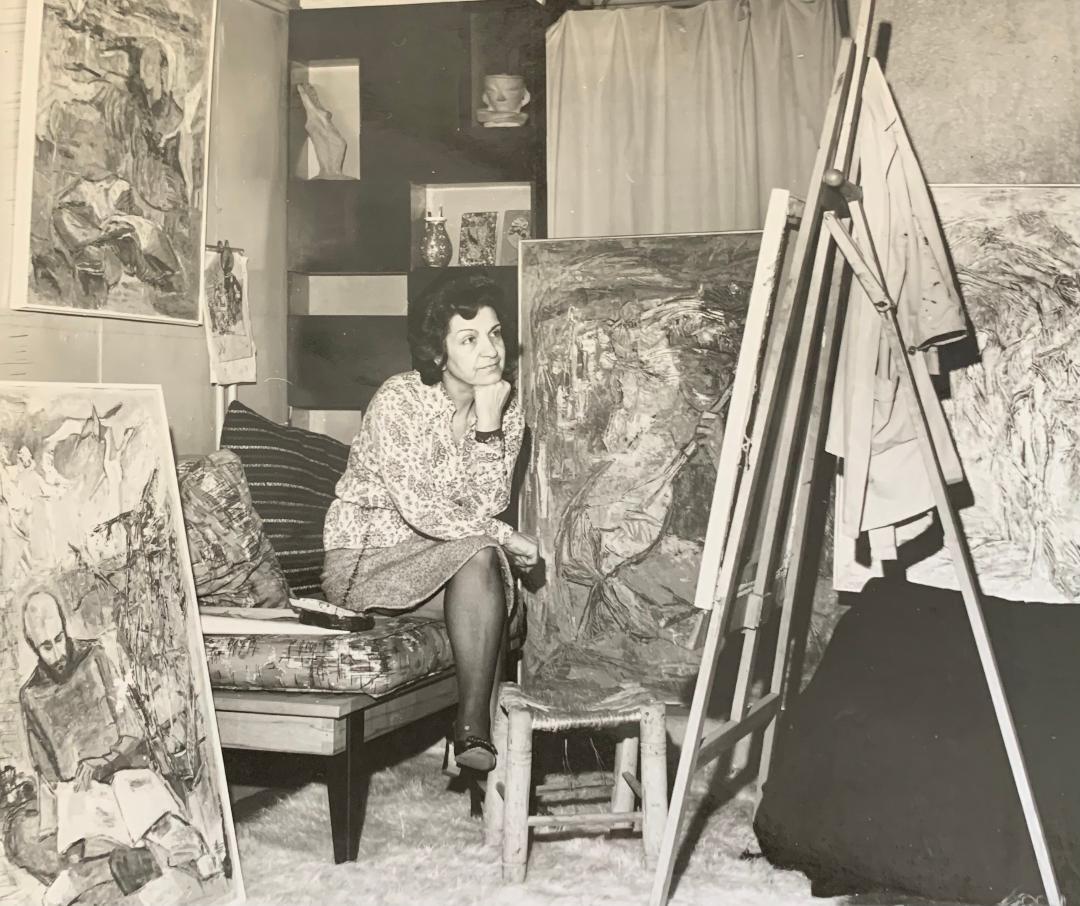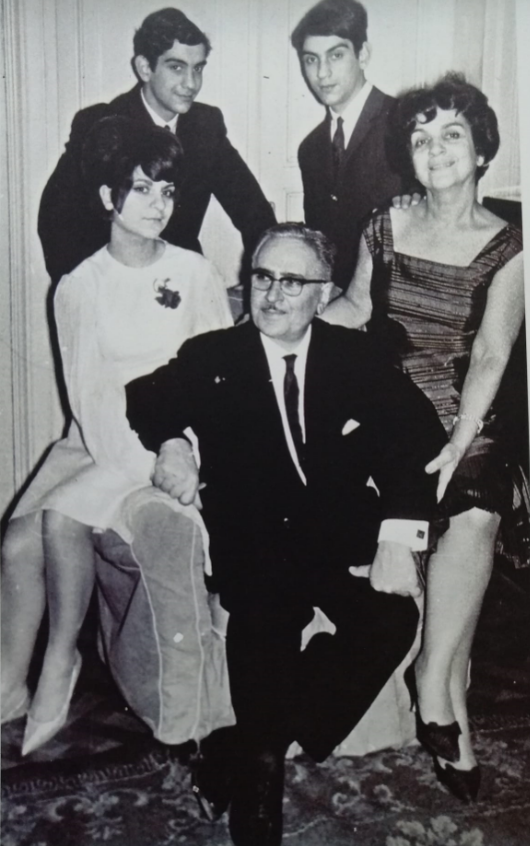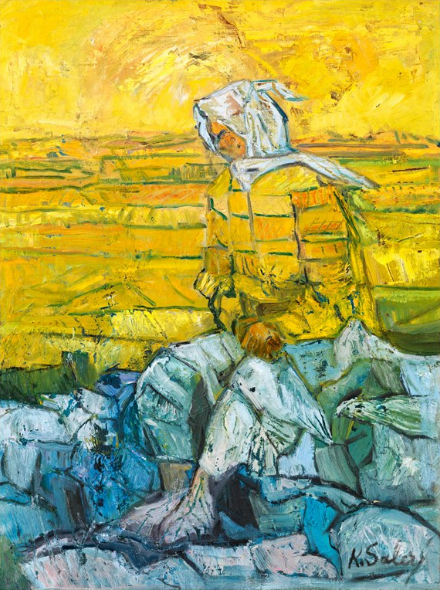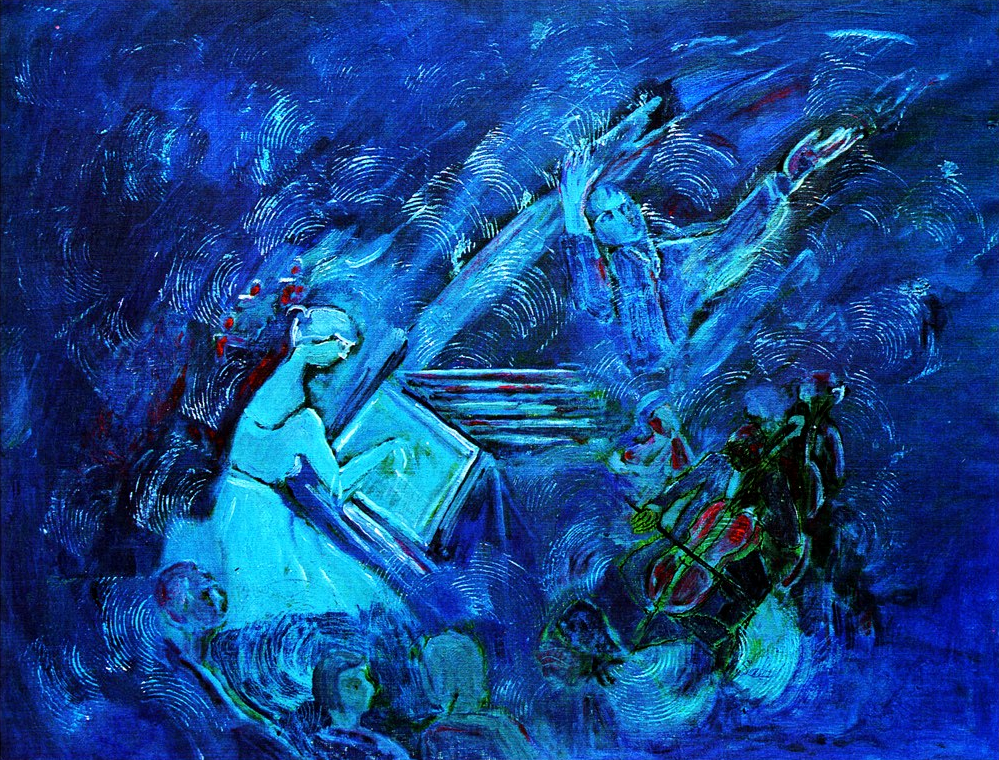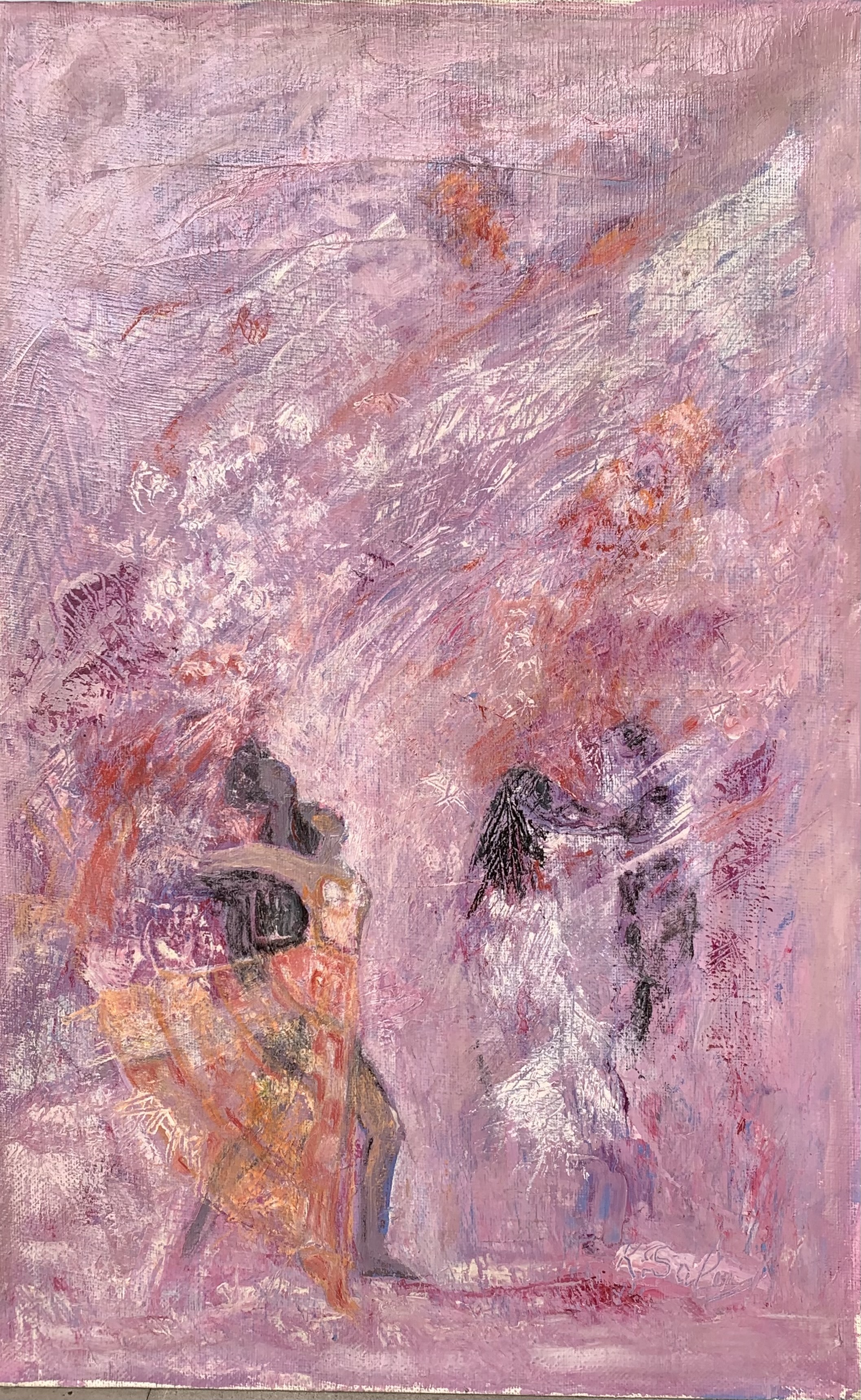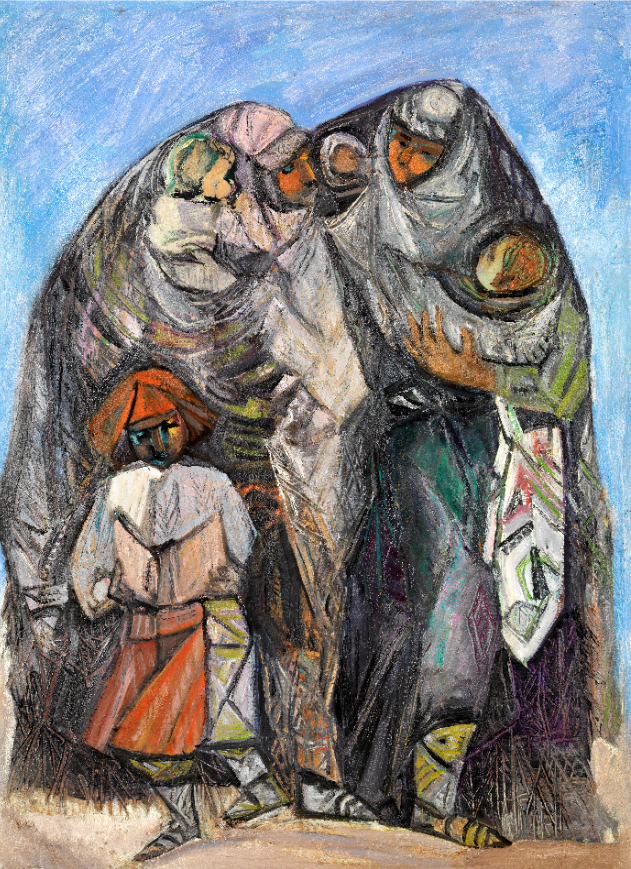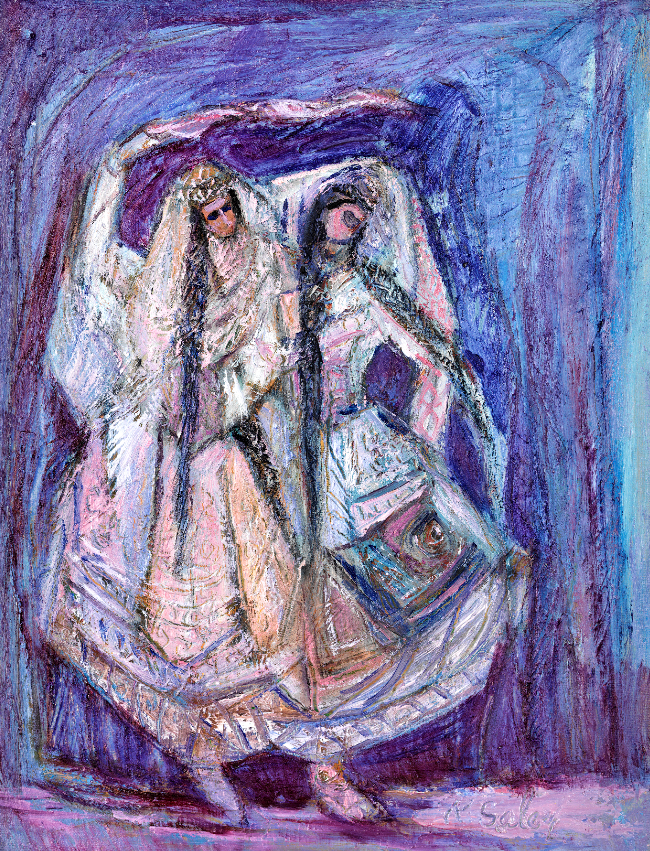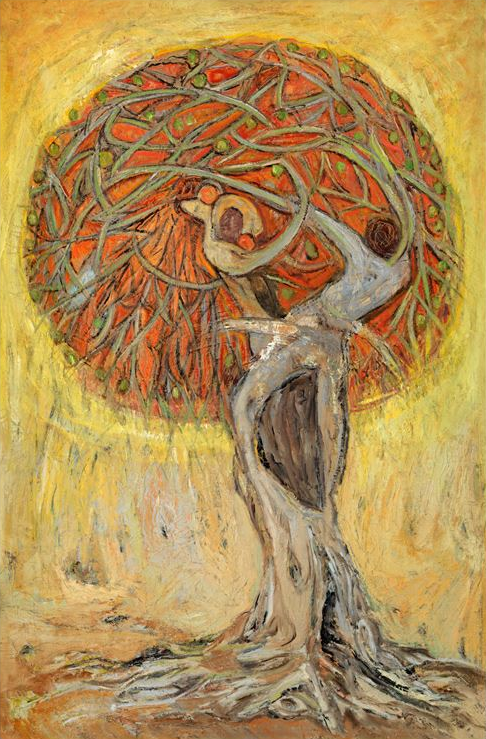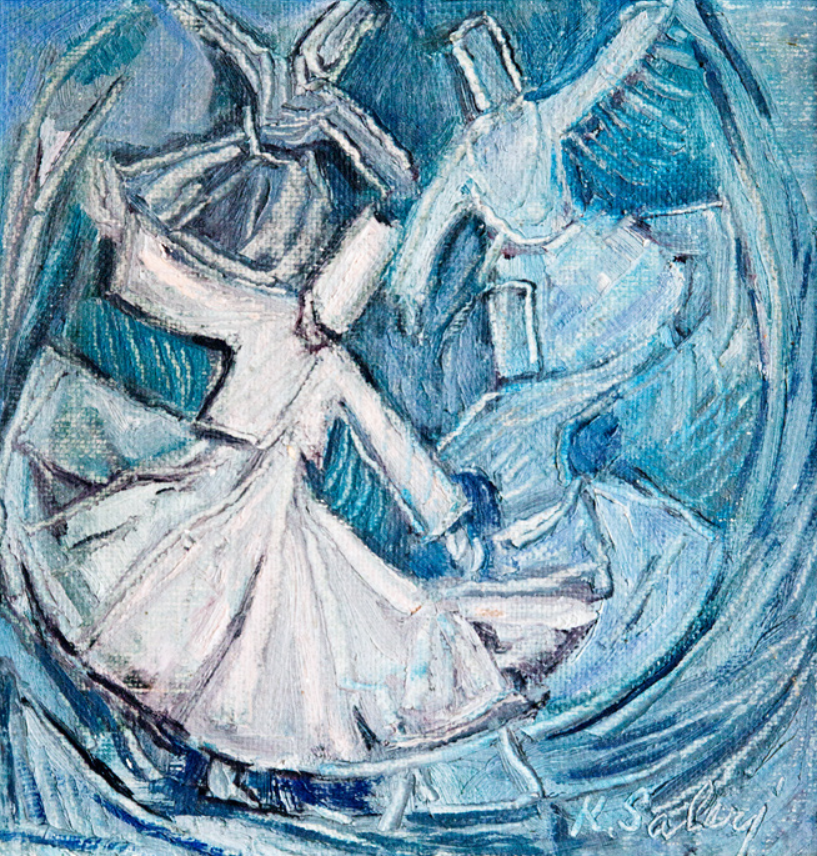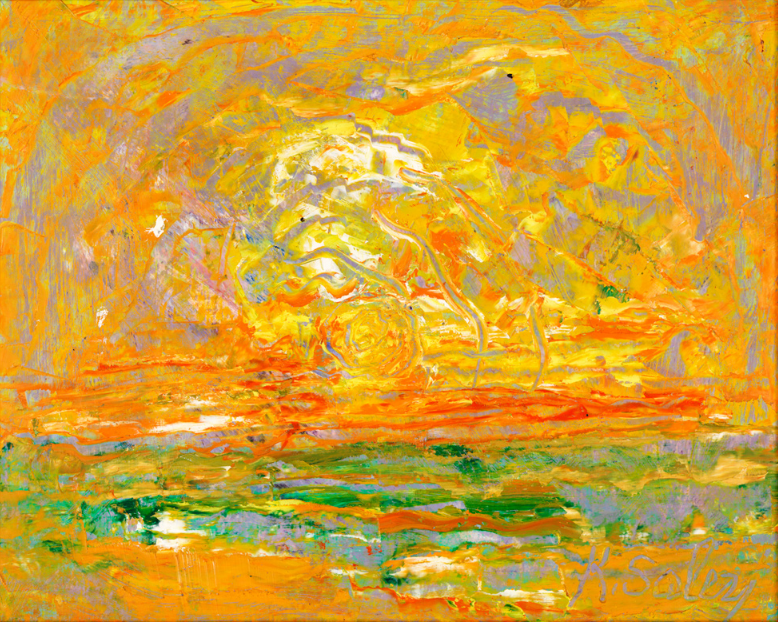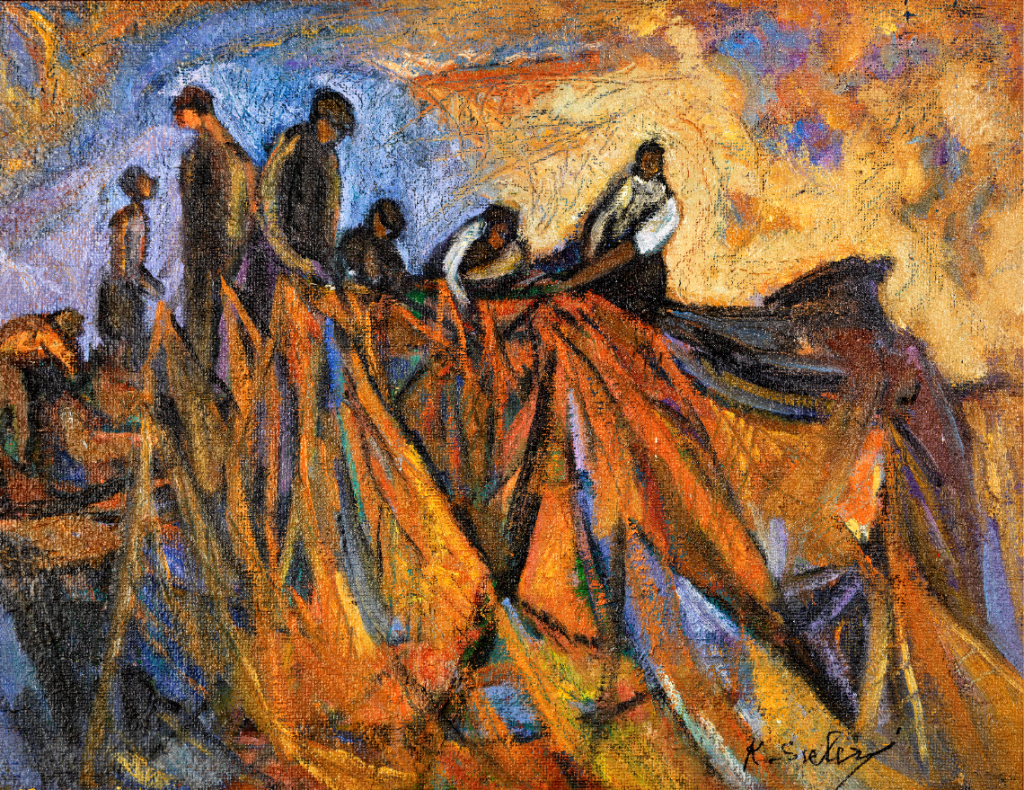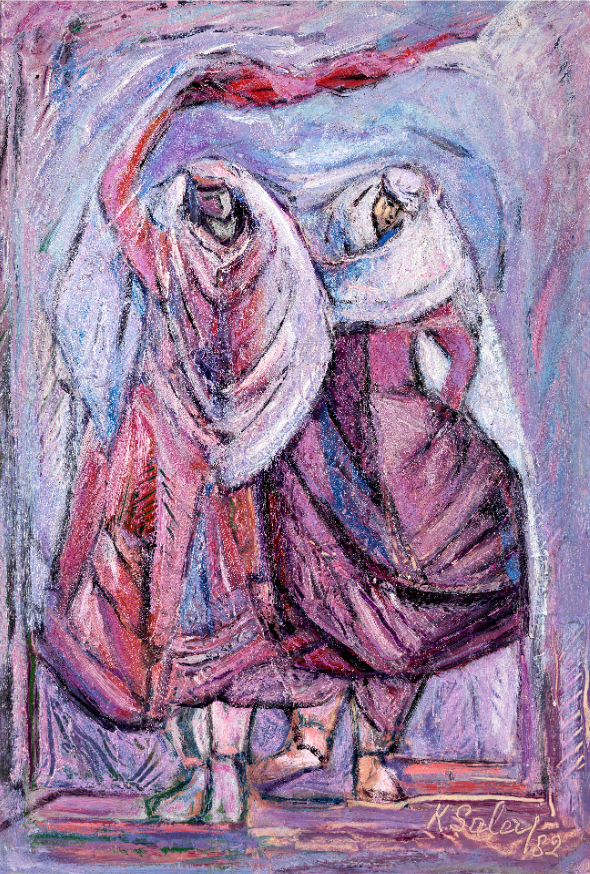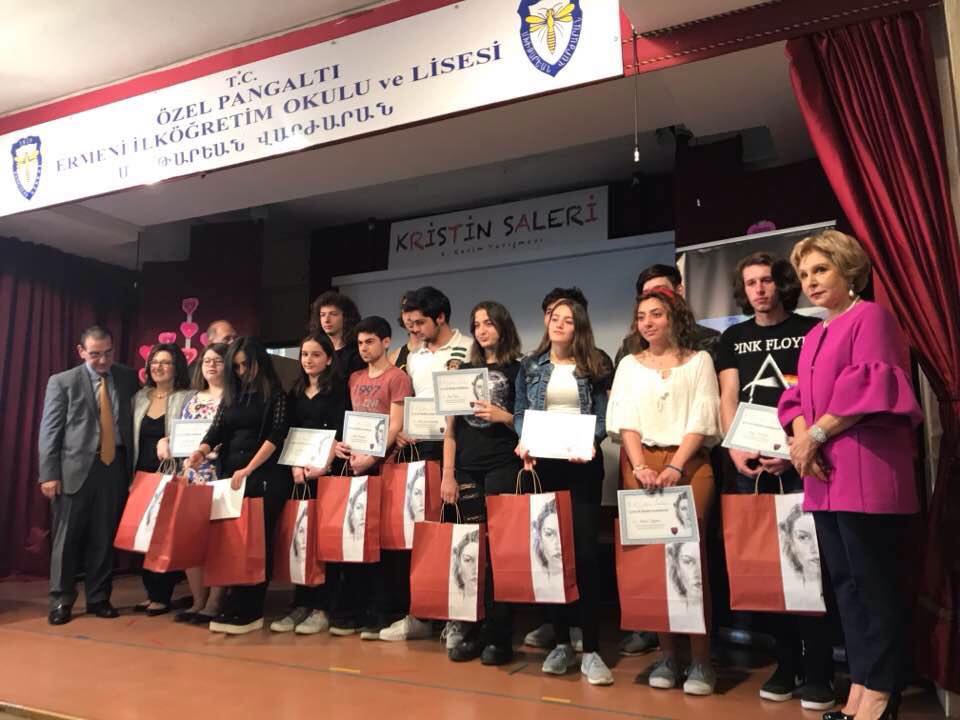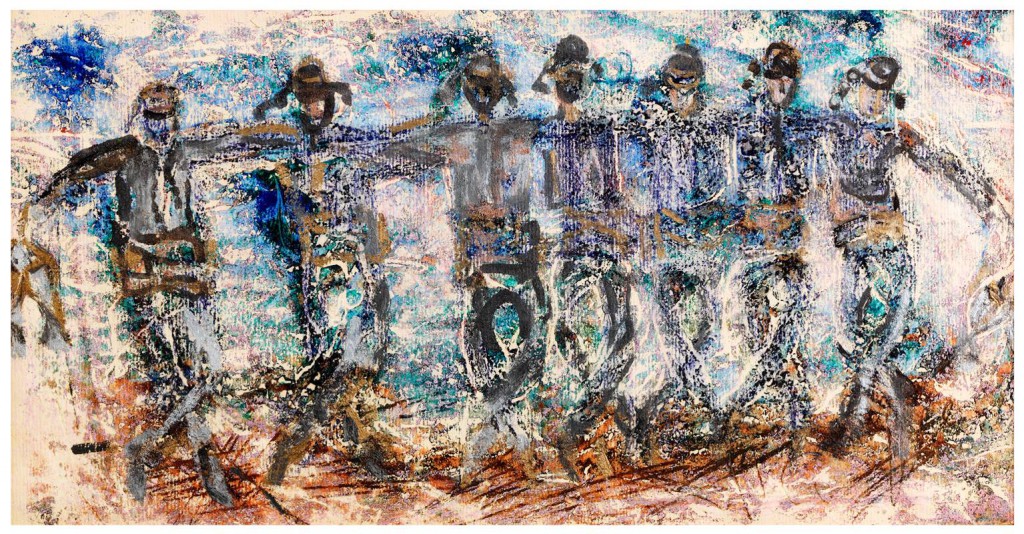Kristin Saleri, 1970
TURKEY: Kristin Saleri (1915-2006)
An extraordinary Armenian female artist of the 20th century
Written by Çiğdem Gül
Germany – January 30, 2021
Welcome to Intercultural Network For The Highly Gifted!
A world that preserves and celebrates our cultural and artistic heritage is a better world.
I feel thrilled to introduce to you to the prominent Armenian artist Mrs. Kristin Saleri, her unique art as well as immerse myself in the inner world of an exceptionally gifted person. I will substantiate my perspective and analysis of the person Kristin Saleri with interview and book quotes from the German psychologist and author Andrea Brackmann. She is one of the leading experts on moderately gifted, highly gifted and geniuses in three native German-speaking European countries. I interviewed Ms. Brackmann about the publication of her new book entitled „Extremely Gifted: The Personality Structure of Exceptionally Gifted Individuals and Geniuses.“ (Original title: „Extrem begabt: Die Persönlichkeitsstruktur von Höchstbegabten und Genies“ on April 25, 2020.
Kristin Saleri was fortunate that her talent was recognized and encouraged early on. Nevertheless, she had to assert herself as a woman and artist with her Armenian roots after the turbulent time in Turkey. In my opinion, she succeeded in doing this very well by not only developing her talents, creativity and art internationally, but above all developing herself ethically. In doing so, she has revolutionized her own dignity and radiant personality. And that makes her a great phenomenon from my point of view. Kristin Saleri recognized that beauty, like art and cultures, always connects us all.
In my opinion, Kristin Saleri is one of our best painters to visualize the lifestyle of Anatolian people, Anatolian women, Anatolian folklore and love, with a human touch. Her works come through a prism of revolutionary French art movement cubism that is influenced by a distinctive abstract figurative technique. Kristin Saleri pursues beauty in all forms and shapes without boundaries and social biases.
Kristin Saleri, circa 1970. Istanbul Studio. Photo by Tele Fotoğraf Ajansı.
Kristin Saleri (1915 – 2006) is one of the most interesting artists of the 20th century. Despite her phenomenal success as an artist during her professional career, her legacy and reputation today, in Turkey and across the international art communities, fall far short of her true contributions to 20th century art. Ironically, being a fading and forgotten star was one of her biggest fears prior to her death.
After studying at the Istanbul Academy of Fine Arts with Prof. DeMille, Kristin Saleri attended courses taught by Feyhaman Duran. Duran was the first and most influential representative of portrait art. In 1959 Kristin Saleri worked at the École de Paris under the guidance of artist André Lhote. She was keenly interested in Cubism as well as in the works of Matisse, Picasso, Cézanne and Van Gogh. Kristin Saleri´s art developed into a distillation of these influences. Upon returning to Istanbul her artwork were combined with themes from her Anatolian homeland and her own Armenian / Christian spiritual background. Kristin Saleri conducted research in Rome, Paris and Munich during the period 1951-1955.
„She held more than 40-plus private shows beginning in 1957 in Istanbul at Ertem Gallery. Contributed to countless group exhibitions around the globe including Ankara, London, Paris, Brussels, Yerevan, Athens, Frankfurt and Washington D.C.. Her works have been acquired by Istanbul Painting and Sculpture Museum, Ankara State Museum, Izmir Painting and Sculpture Museum, Paris Musée National Centre Pompidou, Lisbon Gulbengian Foundation and numerous private collectors worldwide.”[1]
Kristin Saleri was born in Silivri in 1915, the youngest of five children of Armenian parents Onnig and Eftig Agopovich, in the midst of a turbulent and sad period in the history of the Ottoman Empire. Among the Armenian population in Turkey and across the international diaspora, the year 1915 is synonomous with sorrow, tragedy, death and despair. Her uncle Rupen Sevag (1885-1915), a medical doctor, poet, intellectual leader and an officer in the Ottoman Army became one of the early victims of the tragic events of 1915.
The uncle-niece Rupen Sevag and Kristin Saleri were both ahead of their times, both endowed with artistically extraordinary talents. Both exceptionally committed to their principles and convictions. While the story of Rupen Sevag stands for tragedy and deep pain, a life ended so untimely, violently, and unjustly, the story of Kristin Saleri traces a path for rebirth, healing, peace and persevearance through grit and the invisible power of art and creativity.
The Agopovich family, 1919. From left to right: Sirvart, Kirkor, Eftig (the mother), Adrienne, Onnig (the father), Kristin, and Sira.
Tevfik İhtiyar: »Kristin Saleri has conveyed through her canvas the cultural wealth and the centuries-long heritage of her land filled with the rich mores of diverse peoples. Her works bring to life the vast and mystical landscape, its music, folk dances, the mournful love songs, as well as the sage woman, `Mother Ülkiye´ of Anatolia, the Bosphorus fish and fishermen, and the poignant love of the pine trees at Prince´s Islands.«
Kristin Saleri spent her childhood and school years at her parents‘ farm in Florya (a suburb of Istanbul). She was a hyperactive and rebelling child when compared to her siblings. Like many gifted children, she was a free spirit. Her natural tendency was to observe, imagine, and show initiative. She used to draw portraits of teachers at school and guests visiting her parents. She had no inhibitions about capturing facial features or expressions that were less than flattering to her subjects. And she dared to share her work with them, not a bit intimidated by the consequences.
It is the nature of a genius to be also naive. Artist Kristin Saleri preserved her naivety and human love throughout her life and art life. This meaningful stance, will leave behind a rich and profound art legacy for future generations.
Her primary school was Armenian Catholic Immaculate Conception, while her secondary school education took place at École Moderne, a French educational establishment in Istanbul.
Kristin Saleri grew up in two contrary (Armenian-Turkish) cultures and (Christian-Muslim) religions in the midst of many others. In this intercultural and interreligious context, she had the multi-perspective privilege of deciding each time anew in which she encountered herself and how this affected the way she felt. During the process of creating her work, a certain color, motif, object etc. can have triggered different things in her, depending on whether she chose the Armenian or the Turkish perspective.
In 1943 Kristin Saleri married Agop Arshavir Saleri, a young graduate of Istanbul Technical University with dual Masters in Electrical and Mechanical Engineering. From this marriage 3 children were born. The daughter Rehan Nazan and three years later the male twins Nansen Garo and Alen Johannes.
1964 İstanbul: Private family photograph of the Saleri family
From back left: Alen J. Salerian, Nansen G. Saleri
In the center from left: Rehan N. Saleri Sarıbay, Kristin Saleri
In the front: Agop Arshavir Saleri
Kristin Saleri started going to Paris every year from 1950 to 1980 to study cubism and abstract art when it was still in its infancy.
Critic and art historian Morgan Falconer offers comments as follows „For Kristin Saleri, art was a medium through which humankind might be brought together. It was a universal language. ]…] Kristin Saleri´s work is disseminated across the globe both in national and international museums, as well as in private collections.“[2]
Dr. Nansen G. Saleri: »Because of the very painful and terrible historical events in 1915, the Armenian community in Turkey and in the worldwide diaspora is very injured emotionally and culturally. The late Hrant Dink used to say, „If you don’t want to refer to these events as genocide, I’ll let you choose your own words.“ My mother Kristin Saleri was never interested in politics. She was not afraid of being an Armenian. Her art is a picture of peace and rebirth. Her art was thematically about going beyond suffering. She conveyed the diversity and richness of different cultures in Anatolia. So my mother injected hope for renewal and connection among cultures. It was no coincidence that she brought Anatolia, the cradle of world civilizations, to life through her works.«
„Since my early childhood, circa 1951, I knew that my mother was extraordinary,“ wrote NGS in his bilingual book about Kristin Saleri.[3] „She completed her initial art training from Prof. DeMille and Feyhaman Duran Studio at the Istanbul Academy of Fine Arts Academy and later under the tutelage of artist André Lhote in Paris. She lived, worked and produced her works of art in Istanbul. She produced over 3,000 (the exact number being unknown) pieces of art during her long career in Istanbul. Oil paintings made up her predominant art medium while ceramics, glass, and charcoal provided alternative, albeit equally creative channels of artistic expression. She was apolitical yet, undeterred by the huge hurdles of being a female artist of Armenian heritage in a period of social and ethnic strain in post World War II Turkey. Kristin Saleri became a leading force in the Turkish art community – co-founder of the International Turkish Female Artists Association (1965), co-chair of Turkish Painters Association – and used her art to convey a message of modern feminism. She was equally a leading artistic voice in Istanbul´s Armenian community organizing art exhibitions and competitions. Her focus was aimed at youth programs via mainly two Armenian high schools – Getronagan and Mkhitaryan. Kristin Saleri Art Foundation (KSAF) is dedicated to her vision.“
In a long phone conversation with NGS, he shared personel insights about his mother Kristin Saleri and himself. His great interest in mother’s art developed early in childhood. His words as follows: “Because of the very painful and terrible historical event in 1915, the Armenian community in Turkey and in the worldwide diaspora is very injured emotionally and culturally. The late Hrant Dink used to say, `If you don’t want to refer to these events as genocide, I’ll let you choose your own words.´ My mother was never interested in politics. She was not afraid of being an Armenian. Her art represents peace and rebirth. It was thematically about going beyond suffering. She conveyed the diversity and richness of different cultures in Anatolia. So my mother injected hope for renewal and connection among cultures. It was no coincidence that she brought Anatolia, the cradle of world civilizations, to life through her works. […] My father Agop was one of her greatest supporters.
My mother asked me on October 30, 2006 at the Yedikule Armenian Hospital in Istanbul, „What will happen to my paintings after I die, will I be forgotten?“ My mother’s fear of being forgotten, while appearing paradoxical, was rooted in her personal experience as a minority. She realized that her relentless drive and personality prevented her marginalization when she was alive. `But after my death, what?´ was the question she struggled with. Without thinking twice I answered: “Your works will never be forgotten, Mom. I promise you that I will introduce your art to the world and make sure, that you will be as well known and live forever like Vincent Van Gogh. My words were not solely the response of a grieving son. They signified my appreciation and respect for the artist Kristin Saleri, who created works of art for a lifetime and united cultures. Less than six hours later, right after midnight, my mother passed away at age 91.“ Kristin Saleri was already considered a self-confident, versatile and internationally distinguished Armenian artist during her lifetime. The fact that she, of all people, feared at the end of her life that she would be forgotten after her death sounds paradoxical at first. In truth, however, it reflects also the reality of the gifted and genius, because they often see the finiteness of life more than others. They are very contradictory beings who can combine opposing properties very well. As IQ increases, so does the inconsistency. This also applies to Kristin Saleri’s very high intelligence and maturity on the one hand, and her naivety on the other. „Geniuses often seem ageless […].“ [4]
The Kristin Saleri Art Foundation[5] (KSAF) was established in 2011 by Dr. Nansen G. and Mrs. Marina S. Saleri to memorialize her contributions to 20th century art.
Rehan N. Saleri Sarıbay: »My mother, Kristin Saleri was an artist who captured the spirit of Anatolian people, particularly women through her art. She had a deep connection with hard working creative people. She was not religious, yet deeply spiritual. This is evident in her paintings depicting symbols of Christianity (fishermen, worshippers and Adam and Eve) as well as her attraction to Rumi via whirling dervishes.«
Ulkiye / The Village Lady, 1964
Ulkiye is unquestionably one of Kristin Saleri’s most celebrated works. In the words of her son, NGS, “Ulkiye was our live-in maid from the mid-1950s to late 1960s. A charming, incredibly wise peasant woman from the Black Sea region, she was more like a loving aunt.” Mother Earth, Ulkiye and the sunset all merge into a symphony of colors – gold, yellow, green, turquoise – conveying the artist’s subliminal message – we are all one.
August 2005: This following Vimeo video is an excerpt from an interview with the then 90-year-old KS at her Burgaz island home/studio in Turkey. NGS conducted the interview. The Vimeo video was produced by Clif Webb.
Çiğdem Gül: »What did the thought style of the genius Kristin Saleri look like when she communicated with people or brought new ideas? And what effect had this way of thinking on her works?«
If a viewer studies Kristin Saleri’s art pictures, she or he will possibly analyze them and their details according to the personal, social, cultural, intercultural aspects, technique and art direction of the artist. When analyzing the paintings, it is even more exciting for a viewer to want to find out what the thought style of a gifted person or a genius like Kristin Saleri looked like. While I am giving you detailed information on this subject, I feel the need to underline that this information is written in the light of my personal experiences, thoughts and determinations. However, one or two points that I will tell you have been confirmed as a result of scientific research.
The thought style of the gifted and genius are completely different from the thought style of the average gifted in the majority society. With gifted people there are excerpts from fast and multi-channel trains of thought – comparable to multi-lane and multi-dimensional highways, on which many very fast moving road cars such as Koenigsegg Agera RS (one of the fastest road cars in the world) drive. Furthermore, mental observations of one’s own trains of themes, thought and feelings alternating between several topics. The central point with this topic is that the changing of the observations of strands of thought, the so-called „thought leaps“, defines the thought style of highly gifted people. There is actually a change in observation, but not a change in thoughts. The subject areas seem to continue. Thus, the gifted person briefly directs their attention during a conversation to other internal issues – like a kind of internal bookkeeping, but in truth all these thoughts continue in parallel. Gifted people also have the ability to connect and network levels of thought with one another. Not only changes in observation of one’s own train of thought, but also the connections of thoughts play a major role in the gifted. Highly gifted people can integrate complex information into an overall impression and thus grasp larger relationships. The gifted have the ability to think about access to higher levels. With the geniuses, the style of thought described above runs many times faster and higher.
With such a multi-layered, fast and complex style of thought, Kristin Saleri will have worked out her subjects in art in a way that was just as multi-layered and complex.
The diversity of the worlds of thoughts is at the root of all kinds of thought styles and cultural differences in ways of thinking. And the world needs all kinds of minds.
Andrea Brackmann: »Without changing perspectives, there would be no changes, no progress, no understanding of other people or ways of life, no ideas for the future.«
With the end of the First World War at the beginning of the twentieth century, a new artistic movement called „Cubism“ emerged as a reaction to the impressionism movement in Paris. Although the artist Kristin Saleri was deeply influenced by the Cubism movement and used cubism in some of her works, she often depicted her works with her own distinctive abstract figurative technique.
Kristin Saleri’s place is unique in the abstract figurative movement of the twentieth century. In the words of NGS: „My mother used to insist `I am neither Paul Cézanne, nor Georges Braque, nor Vincent Van Gogh. I am Kristin Saleri. My paintings do not need to be signed.´ […] Among the many themes that Kristin Saleri dealt with in her work – woman, sexuality, orchestra or children – two aspects were very important to her. First, there is the harmony of colors, which is almost a musical quality in all her paintings. Second, spirituality – the symbolism of Christianity in fishermen, or Rumi´s whirling dervishes representing a virtual bridge to God.“
As an artist, Kristin Saleri not only masterfully painted pictures and designed objects, but she also masterfully empathized with cultures, people and objects. She succeeded in doing this by changing perspectives. At this point I remember the words of the German psychologist and author Ms. Andrea Brackmann. She told me during our interview in April 2020: “Without changing perspectives, there would be no changes, no progress, no understanding of other people or ways of life, no ideas for the future.“
The following is a select sampling of contemporary and classic paintings by Kristin Saleri.
Blue Composition – 1989
It underscores the artist´s connection with music, one of her favorite themes. The harmony of colors, shades of blue, captures the pianist´s inner world.
Kristin Saleri said in an interview in 2005 that one of her favorite motifs in her art is the orchestra. For many creative art geniuses like Kristin Saleri, music and especially orchestra music is not just a question of aesthetics, it also serves to calm them down. Their brain and their thoughts are constantly working at such a high speed that their head can hardly find rest. Andrea Brackmann, German psychologist, expert and author writes the following in her book: [6] „A remarkable number of geniuses regularly need to deepen their knowledge of classical music […]. Listening to music, like singing and making music, seems to have a calming effect on the nervous system.“
The couples dance
The New Generation, The New Turkey – 1988
The young girl with a book in the forefront is contrasted by the veiled women in the background. This painting was attempting to capture the complex nature of Mustafa Kemal Atatürk’s (the founder of the Turkish Republic) initiatives towards the modernization of Turkey.
Dr. Nansen G. Saleri: »The New Generation, The New Turkey: In 1980 my mother Kristin Saleri participated in an art competition organized by The Republican People’s Party (Turkish: Cumhuriyet Halk Partisi, CHP). My mother was widely criticized for this painting because it emphasized veiled women; it was misinterpreted as a criticism of Mustafa Kemal Atatürk, the founder of the modern Turkish Republic. Kristin Saleri was defiant and rejected the criticism with the words: `The most important subject in this painting is the little girl without a headscarf or veil, who stands in front of the veiled women and reads a book.´«
Armenian Dancers – 1980
The late Tevfik İhtiyar, an author, art critic, and publisher says: „Kristin Saleri has conveyed through her canvas the cultural wealth and the centuries-long heritage of her land filled with the rich mores of diverse peoples. Her works bring to life the vast and mystical landscape, its music, folk dances, the mournful love songs, as well as the sage woman, „Mother Ülkiye“ of Anatolia, the Bosphorus fish and fishermen, and the poignant love of the pine trees at Prince´s Islands.“ [7]
The Love Tree – 1980
Kristin Saleri had a profound interest in Christian imagery. According to art historian and critic Morgan Falconer, „one of the motifs she returned to again and again was the tree of life, an ancient symbol given Christian associations by its centrality in the story of Adam and Eve. Saleri often paints the tree of life and The Love Tree as a universal symbol – a symbol for all people, all religions and all time – but just as often she will show Adam and Eve entangled in the tree and reaching for apples.“[8]
Whirling Dervishes in Sync – 1985
The artist was fascinated by Rumi and whirling dervishes and regarded them as a connection with God.
Sunset – 2002
Fishermen´s Catch – 1956
In the words of Laura Kreft, Director of the Fine Arts Museum at Houston Baptist University, Texas, “In a Christian context, Saleri’s theme of fishermen references Christ’s statement to the apostles ‘… follow Me, and I will make you fishers of men.’ Additionally, Saleri is remembering everyday scenes in towns and villages along the coastal villages of Turkey, depicting a sympathetic view of a simpler way of life in an ever-modernizing world. In countless paintings, she created compositions of sails, nets and figures with myriad postimpressionistic hues and impastos.”
Duet – 1979
When analyzing the figures’ costumes, however, it becomes apparent that the artist is painting the same theme with women of different religious affiliations. In „Duet“, the dancers are wearing burkas covering their hair, indicating that they are Muslim women. In „Armenian Dancers“ the hair is exposed and worn in long braids, indicating that they are Armenian Christians.”
The Kristin Saleri Art Foundation, based in Texas / U.S., organizes the “Kristin Saleri Painting Contest”, which attracts great attention every year among the13 Armenian schools in Istanbul. The photograph shows the winners. At the 8th Kristin Saleri Painting Competition held on Saturday, May 11, 2019, at Mkhitaryan High School, Istanbul.
The goal is to memorialize Kristin Saleri, for future generations. The competition is a venue to bring out the artistic talents among youth – something the artist believed was a key to her own success as a child prodigy.
Black Sea Folk Dancers – 1979
Legend / Abbreviations and Relationship to Kristin Saleri
AAS: Agop Arshavir Saleri, husband
RNS: Rehan Saleri Sarıbay, daughter
ATS: Alen Johannes Salerian, son
NGS: Nansen Garo Saleri, son
MSS: Marina Sylvia Saleri, daughter in law
KSAF: Kristin Saleri Art Foundation
Footnotes
[1] Saleri, N. G. and Ihtiyar, T. (2012) : Source of quotation: „Kristin Saleri“, part „Kristin Saleri: Biography“, page 255, RH+ Publication, Istanbul, ISBN: 978-975-97438-6-4
[2] Saleri, N. G. and Ihtiyar, T. (2012) : Critic & art historian Morgan Falconer´s quote source: „Kristin Saleri“, page 34, RH+ Publication, Istanbul
[3] Saleri, N. G. and Ihtiyar, T. (2012) : „Kristin Saleri“, page 13, RH+ Publication, Istanbul
[4] Brackmann, Andrea (2020) : Source of quotation: „Geniuses often seem ageless […].“: „Extremely gifted: The personality structures of the highly gifted and genius“ (Original: „Extrem begabt – Die Persönlichkeitsstruktur von Höchstbegabten und Genies“), 1st edition, page 139. Publishing company Klett-Cotta in Stuttgart, Germany, ISBN: 978-3-608-89258-1.
[5] Kristin Saleri Foundation: http://www.kristinsaleri.com
[6] Saleri, N. G. and Ihtiyar, T. (2012) : Source of quotation: „Kristin Saleri“, see part „Acknowledgements“. RH+ Publication, Istanbul, ISBN: 978-975-97438-6-4
[7] Saleri, N. G. and Ihtiyar, T. (2012) : Source of quotation: „Kristin Saleri“, see part „Acknowledgements“. RH+ Publication, Istanbul
[8] Fresno State´s Henry Madden Library brochure „Discovering Kristin Saleri“, 2016. The Henry Madden Library is the name of an academic library in Fresno, California. It serves as the main resource for recorded knowledge and information supporting the teaching, research, and service functions of the California State University, Fresno.
https://library.fresnostate.edu/content/discovering-kristin-saleri Website: https://library.fresnostate.edu/
Acknowledgements
Wish to convey my special thanks to Kristin Saleri´s children, Mrs. Rehan Nazan Saleri Sarıbay, Dr. Nansen Garo Saleri, Dr. Alen Johannes Salerian and her grandchildren Mrs. Pauline Saleri Borally and Sy Salerian. My big thanks go to Ms. Andrea Brackmann, Ms. Debra Church and Mr. Clif Webb (Creative Director for Discovering Kristin Saleri Exhibit at the Henry Madden Library) in Texas, Houston / U.S.. I also must express my gratitude to the late Mr. Tevfik İhtiyar, editor of RH+ Magazine, for his tireless efforts in promoting Kristin Saleri’s contributions to 20th century art.
Special Note
All images, photographs and the Vimeo video are 2021 © Courtesy of KSAF, NGS, RSS
Kristin Saleri Art Foundation
Address:
909 Fannin, Suite 2200
Houston, Texas 77010
Website:
Çiğdem Gül, born 1971 in Gümüşhane / Turkey, is a Turkmen nomad with Alevi-Turkish origin, Persian roots and German citizenship. When she was 4 years old, her family emigrated from Eastern Turkey to Germany.
She is a graduate Economist, Change Management Consultant, Business Coach, Founder of the worldwide „Intercultural Network For The Highly Gifted“ (INHG) and Journalist for language combination Turkish, German and English. The spectrum of her previous professional fields extends in the areas of Business Administration and Economy – Law – Business Consulting, Business Coaching, Training – Public Relations – Art, Culture and Theatre. With her humane, multi-perspective and multicultural attitude, Çiğdem Gül always looks at all issues from the perspective of human rights. And so it happened that on May 4th, 2019 she gave her lecture „Ethics for She-Conomy: Success Strategies from Developing Countries“ in Frankfurt am Main / Germany at Europe’s leading trade fair congress for women and career „women&work“ on the main topic „Humanism 4.0″. Her presentation was based on her multilingual, personal interviews with very well-known and successful women in Argentina, Colombia, Pakistan and Turkey.
Please refer to INHG´s webseite for more detailed information:
Website: www.interkulturellhochbegabte.de
E-Mail address: info@interkulturellhochbegabte.de
